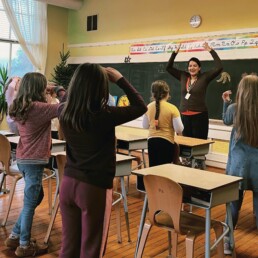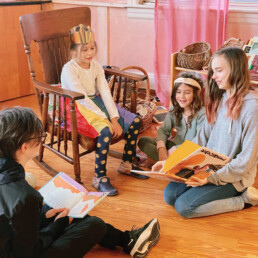Admissions
We invite you to explore a curriculum where early childhood is rich with language, movement, and imaginative play; where science, math, and history are enlivened with art, music, and creativity; where children are engaged, inspired, and motivated. Discover what makes Waldorf education the fastest-growing independent school movement in the world!

Visiting SWS is the best way to experience Waldorf education. Take your first step by scheduling a tour or attending an Open House.
Email admissions@susquehanna.org for more information.

At SWS, we believe in the value of a full and rich Waldorf education. To this end, we strive to make a complete Waldorf experience accessible to as many families as possible. Our tuition is carefully planned to provide the support needed to keep our programs, teachers, and community flourishing.
2024-2025 Admissions Events
Meet teachers and class parents, see student work, and tour our beautiful school.
Admissions FAQs
Waldorf students have been accepted in and graduated from a broad spectrum of colleges and universities including Stanford, UC Berkeley, Harvard, Yale, Brown, and all of the top universities. Waldorf graduates reflect a wide diversity of professions and occupations including medicine, law, science, engineering, computer technology, the arts, social science, government, and teaching at all levels. Waldorf high schools can provide specific data on the university affiliations, professions, and accomplishments of their graduates.
Hear From Our Alums
A Waldorf class teacher ideally stays with a group of children through the eight elementary school years.
The class teacher is not the only teacher the children experience. Each day, specialty subject teachers teach the children eurythmy, handcrafts, world languages, instrumental music, and so on. The class teacher is, however, responsible for the two-hour “main lesson” every morning and usually also for one or two lessons later in the day. In the main lesson, they bring all the main academic subjects to the children, including language arts, the sciences, history, and mathematics, as well as painting, music, clay modeling, and so on. The teacher does deal with a wide range of subjects, and thus the question is a valid one.
A common misconception in our time is that education is merely the transfer of information. From the Waldorf point of view, true education also involves the awakening of capacities—the ability to think clearly and critically, to empathetically experience and understand phenomena in the world, to distinguish what is beautiful, good, and true. The class teacher walks a path of discovery with the children and guides them into an understanding of the world of meaning, rather than the world of cause and effect.
Waldorf class teachers work very hard to master the content of the various subjects that they teach. But the teacher’s ultimate success lies in their ability to work with those inner faculties that are still “in the bud,” so that they can grow, develop, and open up in a beautiful, balanced, and wholesome way. Through this approach to teaching, the children will be truly prepared for the real world. They are provided then with the tools to productively shape that world out of a free human spirit.
from Five Frequently Asked Questions by Colin Price, Renewal Magazine, Spring/Summer 2003
Children who transfer to a Waldorf school in the first four grades usually are up to grade in reading, math, and basic academic skills. However, they usually have much to learn in bodily coordination skills, posture, artistic and social activities, cursive handwriting, and listening skills. Listening well is particularly important since most of the curricular content is presented orally in the classroom by the teacher. The human relationship between the child and the teacher is the basis for healthy learning, for the acquiring of understanding and knowledge rather than just information.
Children who are used to learning from computers and other electronic media will have to adjust. Those children who enter a Waldorf school in the middle grades often bring much information about the world. This contribution should be recognized and received with interest by the class. However, these children often have to unlearn some social habits, such as the tendency to experience learning as a competitive activity. They have to learn to approach the arts in a more objective way, not simply as a means for personal expression. In contrast, in their study of nature, history, and the world, they need to relate what they learn to their own life and being.
The popular ideal of “objectivity” in learning is misguided when applied to elementary school children. At their stage of development, the subjective element is essential for healthy learning. Involvement in what is learned about the world makes the world truly meaningful to them. Children who transfer out of a Waldorf school into a public school during the earlier grades probably have to upgrade their reading ability and approach the science lessons differently. Science in a Waldorf school emphasizes the observation of natural phenomena rather than the formulation of abstract concepts and laws. On the other hand, the Waldorf transferees are usually well prepared for social studies, practical and artistic activities, and mathematics. Children moving during the middle grades should experience no problems. In fact, in most cases, transferring students of this age group find themselves ahead of their classmates. The departing Waldorf student is likely to take along into the new school a distinguishing individual strength, personal confidence, and love of learning.
This question often arises because of a parent’s experience of public school education. In most public schools, a teacher works with a class for one, maybe two years. It is difficult for the teacher and child to develop the deep human relationship that is the basis for healthy learning if change is frequent. If a teacher has a class for several years, the teacher and the children come to know and deeply understand each other. The children, feeling secure in a long-term relationship, are better able to learn.
The interaction of teacher and parents also can become more deep and meaningful over time, and they can cooperate in helping the child. Serious problems between teachers and children, and between teachers and parents, do arise. When this happens, the college of teachers studies the situation, involves the teacher and parents—and, if appropriate, the child—and tries to resolve the conflict. If the differences are irreconcilable, the parents might be asked to withdraw the child, or the teacher might be replaced. In reality, these measures very rarely need to be taken.
A Waldorf class is something like a family. If a mother in a family does not get along with her son during a certain time, she does not consider resigning or replacing him with another child. Rather, she looks at the situation and sees what can be done to improve the relationship. In other words, the adult assumes responsibility and tries to change. This same approach is expected of the Waldorf teacher in a difficult situation. In almost every case they must ask themself: “How can I change so that the relationship becomes more positive?” One cannot expect this of the child. The experience is that with the goodwill and active support of the parents, the teacher concerned can make the necessary changes and restore the relationship to a healthy and productive state.
There is evidence that normal, healthy children who learn to read relatively late are not disadvantaged by this, but rather are able quickly to catch up with, and may overtake, children who have learned to read early. Additionally, they are much less likely to develop the “tiredness toward reading” that many children taught to read at a very early age experience later on. Instead, there is lively interest in reading and learning that continues into adulthood. Some children will, out of themselves, want to learn to read at an early age. This interest can and should be met, as long as it comes in fact from the child. Early imposed formal instruction in reading can be a handicap in later years, when enthusiasm toward reading and learning may begin to falter. If reading is not pushed, a healthy child will pick it up quite quickly and easily.
Some Waldorf parents become anxious if their child is slow to learn to read. Eventually, these same parents are overjoyed at seeing their child pick up a book and not put it down and become from that moment a voracious reader. Each child has their own optimal time for “taking off.” Feelings of anxiety and inferiority may develop in a child who is not reading as well as their peers. Often this anxiety is picked up from parents concerned about the child’s progress. It is important that parents deal with their own and their child’s apprehensions.
Human growth and development do not occur in a linear fashion, nor can they be measured. What lives, grows, and has its being in human life can only be grasped with that same human faculty that can grasp the invisible metamorphic laws of living nature.
Waldorf schools are non-sectarian and non-denominational. They educate all children, regardless of their cultural or religious backgrounds. The pedagogical method is comprehensive, and, as part of its task, seeks to bring about recognition and understanding of all the world cultures and religions. Waldorf schools are not part of any church. They espouse no particular religious doctrine but are based on a belief that there is a spiritual dimension to the human being and all of life. Waldorf families come from a broad spectrum of religious traditions and interests.
It is easy to fall into the error of believing that education must make our children fit into society. Although we are certainly influenced by what the world brings us, the fact is that the world is shaped by people, not people by the world. However, that shaping of the world is possible in a healthy way only if the shapers are themselves in possession of their full nature as human beings. Education in our materialistic, Western society focuses on the intellectual aspect of the human being and has chosen largely to ignore the several other parts that are essential to our well-being. These include our life of feeling (emotions, aesthetics, and social sensitivity), our willpower (the ability to get things done), and our moral nature (being clear about right and wrong). Without having these developed, we are incomplete—a fact that may become obvious in our later years when a feeling of emptiness begins to set in. That is why in a Waldorf school, the practical and artistic subjects play as important a role as the full spectrum of traditional academic subjects that the school offers. The practical and artistic are essential in achieving a preparation for life in the “real” world.
Waldorf Education recognizes and honors the full range of human potentialities. It addresses the whole child by striving to awaken and ennoble all the latent capacities. The children learn to read, write, and do math; they study history, geography, and the sciences. In addition, all children learn to sing, play a musical instrument, draw, paint, model clay, carve and work with wood, speak clearly and act in a play, think independently, and work harmoniously and respectfully with others. The development of these various capacities is interrelated. For example, both boys and girls learn to knit in grade one. Acquiring this basic and enjoyable human skill helps them develop manual dexterity, which after puberty will be transformed into an ability to think clearly and to “knit” their thoughts into a coherent whole.
Preparation for life includes the development of a well-rounded person. Waldorf Education has as its ideal a person who is knowledgeable about the world and human history and culture, who has many varied practical and artistic abilities, who feels a deep reverence for and communion with the natural world, and who can act with initiative and in freedom in the face of economic and political pressures. There are many Waldorf graduates of all ages who embody this ideal and who are perhaps the best proof of the efficacy of the education.



